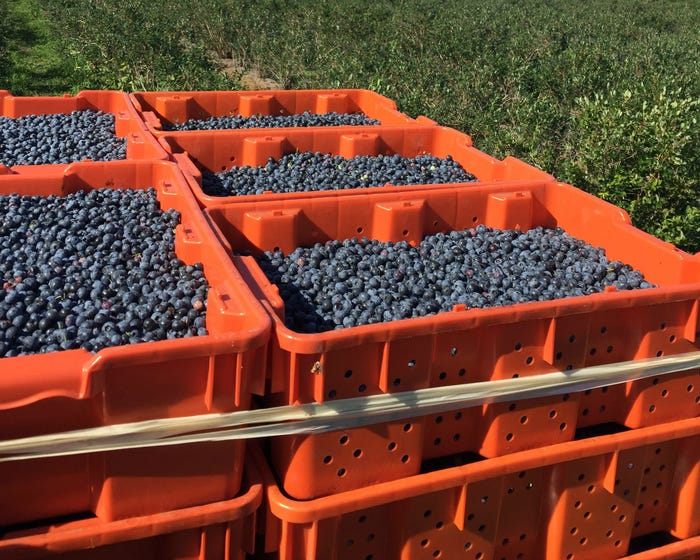June 12, 2018

In 1920, Dr. Stanley Johnson planted the first test plots of commercial blueberries at Michigan State College’s research station in South Haven. Shortly after, growers started growing berries commercially in the area, according to Jacob Clemons, former chairman of the Michigan Blueberry Commission.
“With them being native to Michigan, it was a perfect area for them to thrive,” he says.
By the 1950s, there were 2,000 acres planted to blueberries. The sandy soils and microclimates throughout southwest Michigan are ideal for the crop, Clemons says.
Today, Michigan leads the U.S. in the number of cultivated blueberry acres, producing about 20% (100 million pounds) of the nations’ supply on 21,000 acres.
Michigan growers are interested in growing the industry further, and last year it approved a referendum for a new state blueberry checkoff to fund critical research needs of the industry.
After about $300,000 was collected from growers last season, the first round of research is expected this year. Governed by the Michigan Blueberry Commission, the checkoff assesses growers up to three-tenths of a cent per pound of blueberries sold.
The program’s goal is to keep Michigan’s blueberry industry on the cutting edge of new technology, as well as to implement new research keeping the state’s farmers economically competitive in the growing world market.
Clemons is a second-generation blueberry grower from South Haven, and the farm manager for Berry Fresh Farms LLC in Pullman. He says his father’s retirement plan was to buy a blueberry farm, and in 1995, his father, Bobbie, became a grower. Over the past 20 years, the farm has more than quadrupled its blueberry acreage and now grows 90 acres of blueberries.
Clemons says growers want to develop more control measures to combat blueberry pest and diseases, and avoid resistance issues. “As new pressures have come to bear on us, we’ve had to change our approaches in pruning, sprayer application technology and using our tools every five days, which is a huge cost for us,” he explains.
Fifth-generation fruit farmer Creela Hamlin grew up in orchards helping her family grow apples, pears and plums in Bangor, while her husband, Matt, also a fifth-generation farmer from South Haven, was more likely to be found in the field growing corn, soybeans, cucumbers, cauliflower and cereal grains.
Hamlin says when they first were married, she worked as a specialty crop consultant with blueberry growers and saw the industry as an opportunity they could grow in together. “We started our blueberry farm in 2005. Every year we’ve tried to plant a few more blueberries, and try to make the ones we have better,” she says. The two now operate Lake Michigan Berry in South Haven.
Creela is also a certified crop adviser and current chair of the Michigan Blueberry Com-mission. She says she’s excited that the industry can increase research and band with other specialty crop growers through the new state blueberry checkoff.
“We have seen an insurgence of invasive species — spotted wing drosophila being one of them — that is very impactful,” she explains. “Now we will be able to work closely with other commodity groups such as cherries. If we all band together and work together, we’ll have a much better chance to solve these problems.”
If blueberry growers have a SWD infestation, it breaks down fruit, making it unsalable.
Robson at the helm
Michigan Farm Bureau horticulture and industry relations specialist Kevin Robson is serving as executive director to the Michigan Blueberry Commission.
“I think Michigan’s blueberry growers are some of the most innovative growers in the country — always looking for how to position their farms for what lies ahead,” he says.
Robson believes blueberry stem gull wasp, SWD, and access to foreign and domestic markets are just some of the many challenges that need to be addressed. “It was a beginning group of about 15 growers that worked with the Department of Agriculture and the Michigan Blueberry Advisory Committee and other blueberry organizations that made the program possible,” he says.
Hamlin was one of the original 15. “We started in earnest about three years ago researching how to put a P.A. 232 [Agriculture Commodities Marketing Act for a grower referendum] together with some unique research needs that are very specific to Michigan blueberry growers,” she says.
Supporters extensively evaluated other commodity groups in the state, which have state checkoff programs. A petition was drafted and enough growers signed on to move forward. Almost three-quarters of producers, representing 36 million pounds of production, voted to approve the program last year.
Research expectations
Robson believes the commission will only help grow the industry with one voice working to address different research needs.
“MSU does a great job at working with these growers to develop plans and techniques and problem-solving; however, they can only do so much with the resources that they have. So, it’s imperative that groups like the Michigan Blueberry Commission are put together to provide some of that fiscal resource support,” he explains.

‘TIS THE SEASON: Michigan’s blueberry season runs from July through mid-September. A new checkoff, governed by the Michigan Blueberry Commission, assesses growers up to three-tenths of a cent per pound of blueberries sold for research.

Clemons wants the Michigan Blueberry Commission to help growers stay economically viable. “We have not had a tool or mechanism for us to focus on our own needs,” he explains. “There’s a national checkoff, but it doesn’t necessarily focus on individual state needs.”
Hamlin says as growers battle more invasive species and more agronomic issues, the whole industry needs to come together. “As university research funding has been cut over the years, it is vital for us to be able to steer the research in the ways that are most needed in the field,” she adds.
Clemons thinks more research on the health benefits of blueberries, flavor and multiple applications like fresh, frozen, and processed products have helped grow the industry to supply domestic and international markets. He says Michigan blueberries are typically only promoted in the state, but he’d like to see the marketability increased.
About 60% of Michigan berries are sold as fresh and 40% are processed, but it’s not because of quality differences.
“There are specific varieties that are grown for a processed market, so some may think they’re subpar, but they’re not,” Clemons says. However, prices are stronger for growers in the fresh market. “Prices are starting to rise on processed because we’re starting to focus a little bit more on them and valued-added,” he says.
Clemons would like to see the new Michigan blueberry checkoff address those misconceptions and enhance the profitability of processed berries as well.
Heslip works as the Michigan anchor and reporter for Brownfield Ag News.
About the Author(s)
You May Also Like




